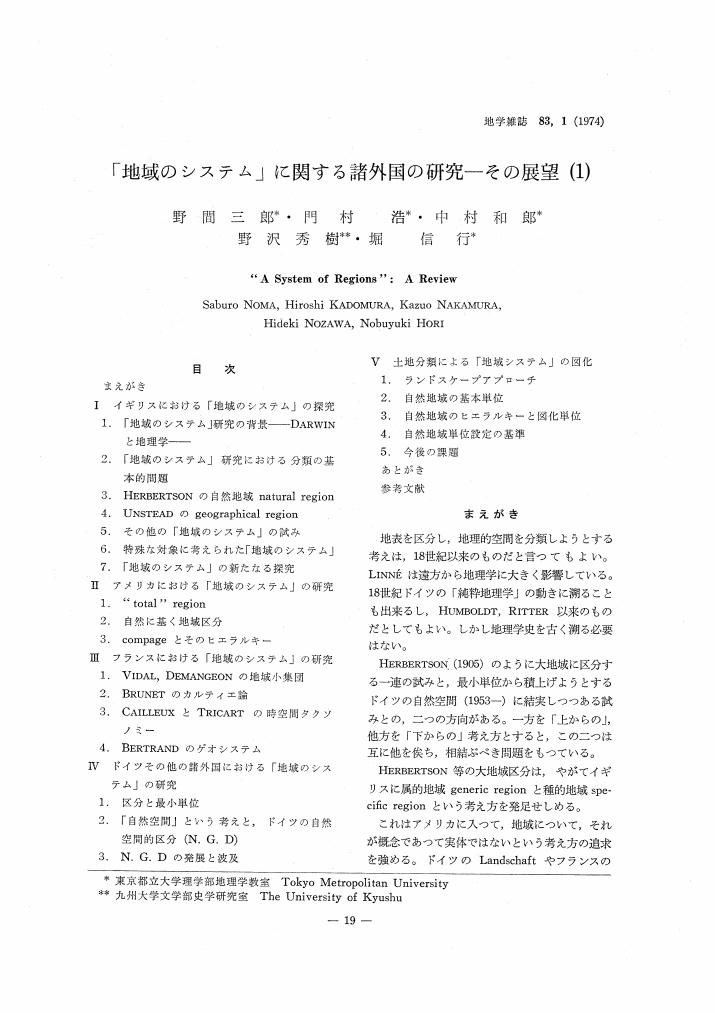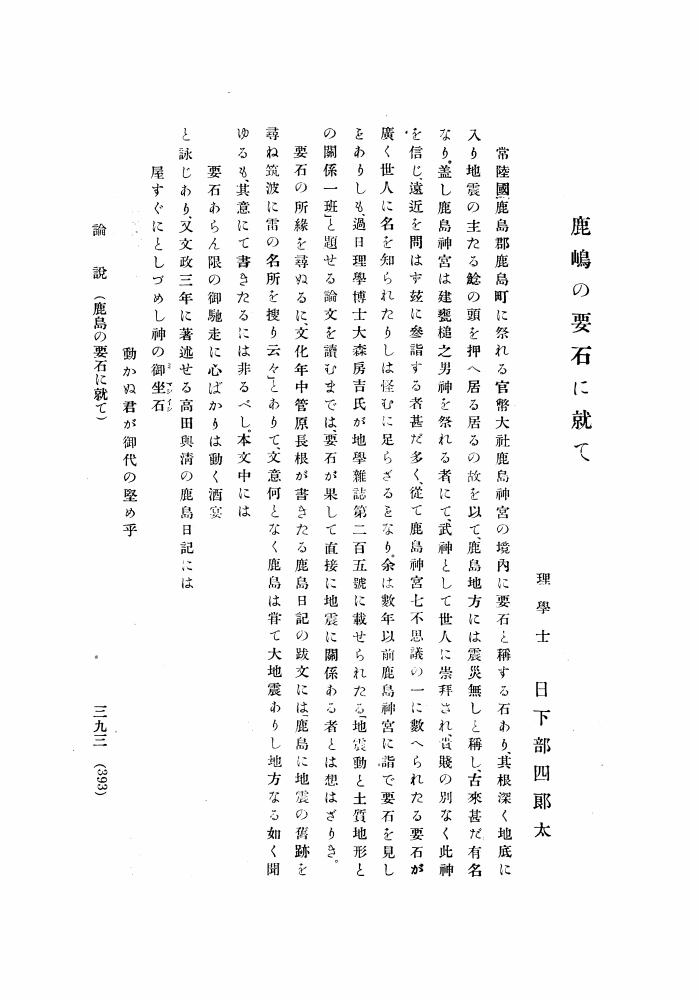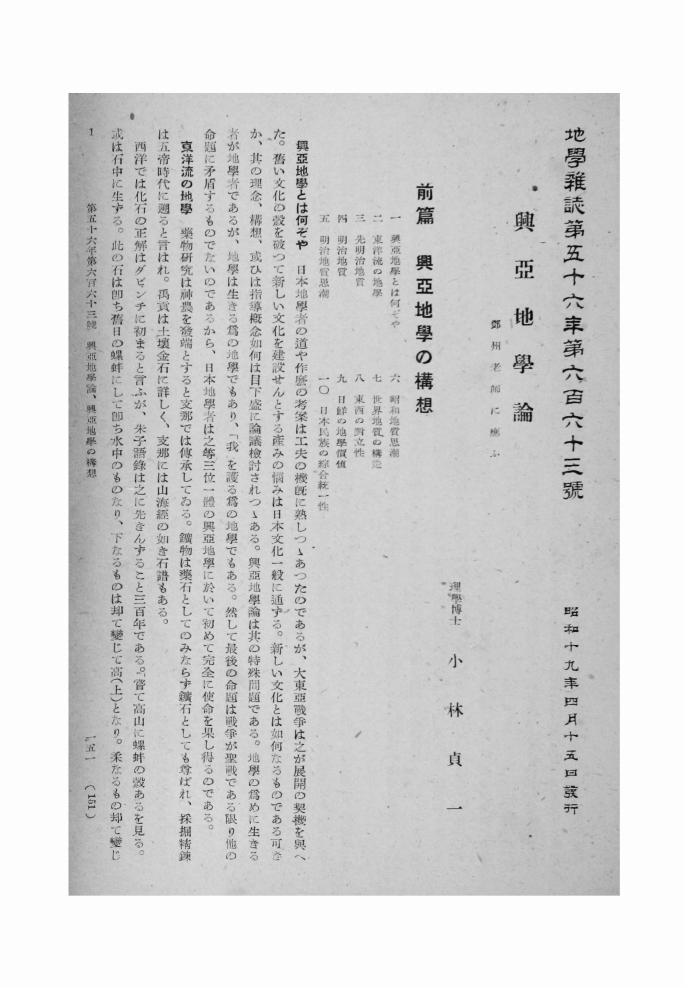1 0 0 0 OA 深海底タービダイトを用いた南海トラフ東部における地震発生間隔の推定
- 著者
- 池原 研
- 出版者
- Tokyo Geographical Society
- 雑誌
- 地学雑誌 (ISSN:0022135X)
- 巻号頁・発行日
- vol.110, no.4, pp.471-478, 2001-08-25 (Released:2009-11-12)
- 参考文献数
- 23
- 被引用文献数
- 12 14
Deep-sea turbidite has potential for paleoseismicity analysis. Many deep-sea turbidites were intercalated in two sediment cores collected from two slope basins off Tokai area along the eastern Nankai Trough. Geological and topographic setting of the basins suggests that these turbidites were of earthquake origin. Depositional age of each turbidite layer was determined by radiocarbon dating using planktonic foraminifera in hemipelagic mud. The results indicated that large earthquakes along the eastern Nankai Trough might have occur periodically every 100-150 years during the last 3000 years.
1 0 0 0 OA 定点カメラ観測ネットワークによる高山帯の消雪と植生フェノロジーのモニタリング
- 著者
- 小熊 宏之 井手 玲子 雨谷 教弘 浜田 崇
- 出版者
- 公益社団法人 東京地学協会
- 雑誌
- 地学雑誌 (ISSN:0022135X)
- 巻号頁・発行日
- vol.128, no.1, pp.93-104, 2019-02-25 (Released:2019-04-03)
- 参考文献数
- 18
- 被引用文献数
- 5 5
The vulnerability of alpine ecosystems to climate change, as pointed out by the Intergovernmental Panel on Climate Change (IPCC), and the necessity to monitor alpine zones have been recognized globally. The Japanese alpine zone is characterized by extreme snowfall, and snowmelt time is a key factor in the growth of alpine vegetation. Therefore, in 2011, the National Institute for Environmental Studies (NIES), Japan, initiated long-term monitoring of snowmelt time and ecosystems in the Japanese alpine zone using automated digital time-lapse cameras. Twenty-nine monitoring sites are currently in operation. In this study, images from the cameras installed at mountain lodges in Nagano Prefecture and around Mt. Rishiri in Hokkaido are used. In addition, live camera images are obtained from cameras already operated by local governments in the Tohoku area and near Mt. Fuji. Red, green, and blue (RGB) digital numbers are derived from each pixel within the images. Snow-cover and snow-free pixels are classified automatically using a statistical discriminate analysis. Snowmelt time shows site-specific characteristics and yearly variations. It also reflects the local microtopography and differs among the habitats of various functional types of vegetation. The vegetation phenology is quantified using a vegetation index (green ratio) calculated from the RGB digital numbers. By analyzing temporal variations of the green ratio, local distributions of start and end dates and length of growing period are illustrated on a pixel base. The start of the green leaf period corresponds strongly to the snowmelt gradient, and the end of the green leaf period to vegetation type and elevation. The results suggest that the length of the green leaf period mainly corresponds to the snowmelt gradient in relation to local microtopography.
1 0 0 0 OA ネパール東部における埋没腐植土層の形成と森林破壊
- 著者
- 宮本 真二
- 出版者
- Tokyo Geographical Society
- 雑誌
- 地学雑誌 (ISSN:0022135X)
- 巻号頁・発行日
- vol.107, no.4, pp.535-541, 1998-08-25 (Released:2014-02-26)
1 0 0 0 OA 我が南洋群島の都市 ガラパン, テニアン, コロールの三都市を中心として
- 著者
- 尾野 作次郎
- 出版者
- 公益社団法人 東京地学協会
- 雑誌
- 地学雑誌 (ISSN:0022135X)
- 巻号頁・発行日
- vol.51, no.12, pp.551-560, 1939-12-15 (Released:2010-10-13)
- 著者
- 鷺谷 威 大坪 誠
- 出版者
- 公益社団法人 東京地学協会
- 雑誌
- 地学雑誌 (ISSN:0022135X)
- 巻号頁・発行日
- vol.128, no.5, pp.689-705, 2019
- 被引用文献数
- 4
<p> Geodetic estimates of crustal strain rates in the Japan islands were an order of magnitude larger than geological/geomorphological estimates, which has been an unresolved problem called the strain rate paradox. Ikeda (1996) postulated that geodetic strain mainly reflects elastic strain accumulation due to interactions at plate boundaries. This hypothesis was proven to be correct by the occurrence of the 2011 <i>M</i><sub>W</sub> 9.0 Tohoku-oki earthquake. Confusion between elastic strain and inelastic strain was the cause of the paradox. Significant postseismic deformation observed after the Tohoku-oki earthquake made it possible to distinguish the inelastic contribution from the geodetically observed crustal strain through a comparison with the pre-seismic strain rate pattern, which promoted a better understanding of inelastic deformation in the Japan islands. On the other hand, migration of localized deformation and temporal changes of strain rate are identified over a geological time scale, implying that it is essential to carefully review the methods and the uncertainties of geological/geomorphological strain rates. An integrated understanding of crustal deformation in the Japan islands is being advanced through detailed investigations of crustal strain rates on variable temporal and spatial scales.</p>
1 0 0 0 伊能忠敬特集号の編集にあたって
- 著者
- 星埜 由尚
- 出版者
- 公益社団法人 東京地学協会
- 雑誌
- 地学雑誌 (ISSN:0022135X)
- 巻号頁・発行日
- vol.129, no.2, pp.155-160, 2020
- 被引用文献数
- 3
1 0 0 0 OA 「地域のシステム」に関する諸外国の研究-その展望 (2)
- 著者
- 野間 三郎 門村 浩 中村 和郎 野沢 秀樹 堀 信行
- 出版者
- Tokyo Geographical Society
- 雑誌
- 地学雑誌 (ISSN:0022135X)
- 巻号頁・発行日
- vol.83, no.2, pp.103-124, 1974-04-25 (Released:2010-02-25)
- 参考文献数
- 157
1 0 0 0 OA 「地域のシステム」に関する諸外国の研究-その展望 (1)
- 著者
- 野間 三郎 門村 浩 中村 和郎 野沢 秀樹 堀 信行
- 出版者
- Tokyo Geographical Society
- 雑誌
- 地学雑誌 (ISSN:0022135X)
- 巻号頁・発行日
- vol.83, no.1, pp.19-37, 1974-02-25 (Released:2009-11-12)
- 被引用文献数
- 1
1 0 0 0 OA 海洋底の歴史
- 著者
- 奈須 紀幸
- 出版者
- Tokyo Geographical Society
- 雑誌
- 地学雑誌 (ISSN:0022135X)
- 巻号頁・発行日
- vol.102, no.6, pp.645-663, 1993-12-05 (Released:2010-11-18)
- 参考文献数
- 19
1 0 0 0 OA E.ナウマン著「日本の経済状態と地質調査所について」邦訳
- 著者
- 山田 直利 矢島 道子
- 出版者
- 公益社団法人 東京地学協会
- 雑誌
- 地学雑誌 (ISSN:0022135X)
- 巻号頁・発行日
- vol.125, no.2, pp.257-267, 2016-04-25 (Released:2016-05-12)
- 参考文献数
- 9
Edmund Naumann (1854–1927), the first professor of the Geological Institute, Science Department, the University of Tokyo, presented a proposal to found the Geological Survey of Japan to Hirobumi Ito, Minister of the Home Affairs of Japan, in 1879. The Japanese Government immediately accepted this proposal, so Naumann resigned his post as a professor of the university and returned to Germany, in order to find the necessary specialists and items for the upcoming survey. During his stay in Germany, on January 3rd, 1880 he gave an invitation lecture on Japan, which was published in “die geologische Verhandlungen der Gesellschaft für Erdkunde zu Berlin” as a paper titled “Ueber die wirthschaftlichen Verhältnisse Japans und die geologische Aufnahme des Landes” (The economic situation of Japan and the Geological Survey of Japan). This paper introduced the feudal system, which had controlled Japan through the Middle to Modern ages, the economic situation of Japan after the Meiji Restoration, especially for agriculture, means to promote Japanese agriculture and industry, and the purpose and tasks of the Geological Survey of Japan. The paper, which we have now translated into Japanese, is important because it is similar to the Japanese translation of the above proposal handwritten in 1879, and the original text of the proposal, probably written in German, has now been lost.
1 0 0 0 OA 鹿嶋の要石に就て
- 著者
- 日下部 四郎太
- 出版者
- 公益社団法人 東京地学協会
- 雑誌
- 地学雑誌 (ISSN:0022135X)
- 巻号頁・発行日
- vol.18, no.6, pp.393-403, 1906-06-15 (Released:2010-10-13)
1 0 0 0 OA 特集号「地殻からマントルまで : モホ(面)とは何か?」はじめに
1 0 0 0 OA 高速煙り型雪崩
- 著者
- 前野 紀一
- 出版者
- Tokyo Geographical Society
- 雑誌
- 地学雑誌 (ISSN:0022135X)
- 巻号頁・発行日
- vol.98, no.6, pp.761-767, 1989-12-05 (Released:2009-11-12)
- 参考文献数
- 22
1 0 0 0 OA 最小ゲノム —細胞が生きるために必要な遺伝子数はいくつか—
- 著者
- 馬場 知哉 柿澤 茂行 森 宙史 車 兪澈 黒川 顕 大島 拓
- 出版者
- 公益社団法人 東京地学協会
- 雑誌
- 地学雑誌 (ISSN:0022135X)
- 巻号頁・発行日
- vol.129, no.6, pp.805-824, 2020-12-25 (Released:2021-01-18)
- 参考文献数
- 103
- 被引用文献数
- 3
Estimating the “minimal gene set” for a cell to be viable is an important issue in understanding “living” cells, creating “artificial” cells, and revealing “ancient” cells. The minimal gene set is critical information for understanding a cell system and designing an artificial genome, which is an essential element for creating an artificial cell. Artificial cells can provide many clues to understanding primordial life on Earth. To reveal minimal gene sets, “essential genes” in many bacteria, which could not be removed from bacterial genomes, have been identified. Bacteria are the most useful organisms for identifying essential genes from their specific characteristics: small genomes, rapid growth, and species that are easy to manipulate genetically. Therefore, various investigations on minimal gene sets or minimal genome of bacteria are reviewed, and “the minimal gene set for a viable cell” is discussed.
1 0 0 0 OA 重力からみたフォッサマグナの構造とテクトニクス
- 著者
- 萩原 幸男
- 出版者
- Tokyo Geographical Society
- 雑誌
- 地学雑誌 (ISSN:0022135X)
- 巻号頁・発行日
- vol.99, no.1, pp.72-80, 1990-02-25 (Released:2010-11-18)
- 参考文献数
- 13
- 被引用文献数
- 2
The Itoigawa-Shizuoka Tectonic Line (ISTL) forms the western margin of the Fossa Magna separating the Northeast Japan from the Southwest Japan. The conventional idea insists that both the Northeast Japan and the Southwest Japan belong to the Eurasian plate (EUR). A hypothesis has recently proposed, however, that the Northeast Japan belongs to the North-American plate (NAM), while the Southwest Japan belongs to EUR. If we approve the hypothesis, it follows that ISTL is a plate boundary between these two plates. The purpose of this paper is to define ISTL as a kind of plate collision boundaries on the basis of gravity data.ISTL runs across a positive Bouguer anomaly belt with the width of about 30km located on the Japan-Sea coast. The Bouguer anomaly there is about 30 mgal higher in the west side of ISTL than in the east side. This implies that, if we assume ISTL to be a plate subduction boundary, the eastern plate sinks down the western one along ISTL. On the other hand, the inland part of ISTL between Omachi and Matsumoto cities is characterized by a large NS-trending thrust called “East Matsumoto Basin Fault”, the west side of which subsides down the east side. The existence of this thrust is confirmed by both gravity and explosion seismic data. The movement of this thrust is evidently opposite to the plate sinking on the Japan-Sea coast.ISTL turns its way to the NW-SE direction at the south end of the East Matsumoto Basin Fault. The left-lateral slip is predominant from Suwa to Kofu cities, and its horizontal displacement amounts to about 12 km long from geological considerations. The leftlateral movement there can be interpreted from a crustal compression in the EW direction which is caused by a plate collision. The graben lies along this part of ISTL. We find a gravity difference amounting to 20-30 mgal at its maximum between the inside and the outside of the graben. Assuming that a density contrast of basement with sediment buried in the graben is 0.5g/cm3, we estimate the vertical displacement of the graben wall as 1-1.4 km. Our estimation is consistent with the fact that a 800m deep drilling does not reach the basement in the Suwa basin.If we approve the previously mentioned hypothesis, the Kofu basin is considered to be a tripple junction of three plates: EUR, NAM and the Philippine-Sea plate (PHS). Accordingly, the southernmost part of ISTL is a subduction boundary of PHS sinking down EUR, extending southward to the Suruga trough in the Pacific Ocean. Meanwhile, the NAM-PHS boundary runs southwestward from the Kofu basin to the Sagami trough. The highpass-filtered Bouguer anomaly on the inland part of PHS intensifies NE-SW trending short-wavelength undulations of gravity field, which may reflect the northeastward movement of PHS.Geoscientific investigations can not define the Northeast Japan as a part of NAM, but find sufficient evidence for the fact that ISTL is a collision boundary between EUR and the other continental plate except for the PHS area. The gravity data also support this conclusion.
1 0 0 0 OA 陥没カルデラの構造とその形成メカニズム
- 著者
- 下司 信夫
- 出版者
- 公益社団法人 東京地学協会
- 雑誌
- 地学雑誌 (ISSN:0022135X)
- 巻号頁・発行日
- vol.127, no.2, pp.175-189, 2018-04-25 (Released:2018-06-11)
- 参考文献数
- 47
- 被引用文献数
- 2 2
The fundamental structure of a collapse caldera is subsidence of a block(s) into a magma chamber with the evacuation of a massive volume of magma from the chamber. Decompression of a magma chamber caused by the extraction of magma from a magma chamber coinciding with pyroclastic eruption, effusive eruption, and lateral magma migration drives caldera collapse. Caldera-forming eruptions exhibit wide variations. Caldera-forming pyroclastic eruptions are characterized by a high eruption rate, whereas caldera-forming effusive eruptions have a much lower effusion rate. Caldera collapse caused by a pyroclastic eruption generally occurs within one day, whereas incremental collapses continue for up to one month in the case of some effusive eruptions. Collapse calderas also have wide structural variations. The aspect ratio of the roof of the magma chamber controls the development of caldera faults. The development of multiple caldera faults with a high aspect ratio causes piecemeal collapses, whereas a low aspect ratio results in the subsidence of coherent blocks detached by a simple ring fault. With the progress of caldera subsidence, the caldera structure develops from a flexural down sag to a double-ring fault system, and finally reaches an upward-flaring “funnel shaped” caldera following an intense collapse of the caldera wall. Calderas vary widely in size from 1 km to 100 km, and can also be divided into at least three classes by their internal structures. The largest group of more than 20 km across is characterized by flexural down-sag deformation. The intermediate-size group is characterized by well-developed caldera-border faults. The smallest calderas of less than 10 km across may have piecemeal structures. The existence of a pre-caldera volcanic edifice is also an indicator of differences in the magmatic system. Some calderas form at the summit of a pre-existing stratovolcano or shield volcano, whereas some large calderas form in a cluster of small volcanoes, involving non-volcanic basement rocks. A structural model of caldera development should involve these wide spectrums of collapse calderas. The development of collapse calderas is controlled by variations of magmatic activity, such as eruption style, eruption rate, and duration of eruption, as well as the architectures of their magma storage systems.
1 0 0 0 OA 海洋下部地殻および上部マントルの変質作用と変質鉱物
- 著者
- 野坂 俊夫
- 出版者
- 公益社団法人 東京地学協会
- 雑誌
- 地学雑誌 (ISSN:0022135X)
- 巻号頁・発行日
- vol.117, no.1, pp.253-267, 2008-02-25 (Released:2010-02-10)
- 参考文献数
- 51
- 被引用文献数
- 2 2
Gabbroic rocks recovered from deep holes in the oceanic crust significantly vary in the abundance and assemblage of alteration minerals, showing a close association with the original lithology and distribution of dikes and veins. The mineralogical variation is considered to reflect the durability of primary minerals, accessibility and composition of alteration fluids, and alteration temperature. Textural relationships of alteration minerals suggest a common cooling history of oceanic gabbros from granulite or pyroxene hornfels facies to zeolite facies conditions. It is considered that regardless of spreading rate, the static formation of upper greenschist- to lower amphibolite-facies minerals is the dominant alteration process at the lower crust near oceanic ridges, whereas subgreenschist-facies alteration represents the exhumation histories of gabbroic masses from depth. High-temperature plastic shear zones with almost anhydrous recrystallization of primary minerals develop locally at slow-spreading ridges, and possibly provide pathways for later hydrothermal fluids. In contrast to the gabbroic rocks, oceanic peridotites have a monotonous mineralogy formed during low-temperature serpentinization processes, making it difficult for us to depict their cooling histories or in-situ alteration processes at the upper mantle. The hypothesis that oceanic Moho represents a serpentinization front in peridotites is suitable for the uniformity of crustal thickness inferred from seismological observations, but lacks a rationale for supplying a constant amount of water to the upper mantle or for the cessation of serpentinization at a constant degree. Alternatively, preferential alteration of pyroxene at relatively high-temperature conditions might form the oceanic crust of uniform thickness.
1 0 0 0 OA 興亞地學論
- 著者
- 小林 貞一
- 出版者
- 公益社団法人 東京地学協会
- 雑誌
- 地学雑誌 (ISSN:0022135X)
- 巻号頁・発行日
- vol.56, no.5, pp.151-185, 1944-05-15 (Released:2010-10-13)
1 0 0 0 OA 地学クラブ講演要旨 過去1000年間の気候変動と21世紀の気候予測
1 0 0 0 噴火以前の磐梯山の地形復元
- 著者
- 米地 文夫
- 出版者
- 学術雑誌目次速報データベース由来
- 雑誌
- 地学雑誌 (ISSN:0022135X)
- 巻号頁・発行日
- vol.97, no.4, pp.317-325, 1988
- 被引用文献数
- 5 2







